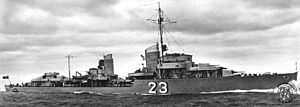German destroyer Z7 Hermann Schoemann
 Z7 Hermann Schoemann c. 1938 | |
| Career (Nazi Germany) | |
|---|---|
| Name: | Z7 Hermann Schoemann |
| Namesake: | Hermann Schoemann |
| Ordered: | 9 January 1935 |
| Builder: | DeSchiMAG, Bremen |
| Yard number: | W901 |
| Laid down: | 15 July 1935 |
| Launched: | 24 March 1936 |
| Completed: | 29 June 1937 |
| Fate: | Scuttled, 2 May 1942 |
| General characteristics as built | |
| Class and type: | Type 1934A-class destroyer |
| Displacement: | 2,171 metric tons (2,137 long tons) |
| Length: | 119 m (390 ft 5 in) o/a 114 m (374 ft 0 in) w/l |
| Beam: | 11.3 m (37 ft 1 in) |
| Draft: | 4.23 m (13 ft 11 in) |
| Installed power: | 70,000 shp (52,000 kW) |
| Propulsion: | 2 shafts, 2 × Wagner geared steam turbines 6 × water-tube boilers |
| Speed: | 36 knots (67 km/h; 41 mph) |
| Range: | 1,825 nmi (3,380 km; 2,100 mi) at 19 knots (35 km/h; 22 mph) |
| Complement: | 325 |
| Armament: | 5 × 1 - 12.7 cm (5 in) guns 2 × 2 - 3.7 cm (1.5 in) guns 6 × 1 - 2 cm (0.79 in) guns 2 × 4 - 53.3 cm (21 in) torpedo tubes 60 mines 32–64 depth charges, 4 throwers and 6 individual racks |
| Service record | |
|---|---|
| Commanders: | Theodor Detmers |
Z7 Hermann Schoemann was a Type 1934A-class destroyer built for Nazi Germany's Kriegsmarine in the mid-1930s.
Design and description
Hermann Schoemann had an overall length of 119 meters (390 ft 5 in) and was 114 meters (374 ft 0 in) long at the waterline. The ship had a beam of 11.3 meters (37 ft 1 in), and a maximum draft of 4.23 meters (13 ft 11 in). She displaced 2,171 metric tons (2,137 long tons) at standard and 3,110 metric tons (3,060 long tons) at deep load. The Wagner geared steam turbines were designed to produce 70,000 shaft horsepower (52,199 kW) which would propel the ship at 36 knots (67 km/h; 41 mph). Steam was provided to the turbines by six high-pressure Wagner boilers[1] with superheaters. Hermann Schoemann carried a maximum of 752 metric tons (740 long tons) of fuel oil which was intended to give a range of 4,400 nmi (8,100 km; 5,100 mi) at 19 knots (35 km/h; 22 mph), but the ship proved top-heavy in service and 30% of the fuel had to be retained as ballast low in the ship.[2] The effective range proved to be only 1,825 nmi (3,380 km; 2,100 mi) at 19 knots (35 km/h; 22 mph).[1]
Hermann Schoemann carried five 12.7 cm SK C/34 guns in single mounts with gun shields, two each superimposed, fore and aft. The fifth gun was carried on top of the rear deckhouse. Her anti-aircraft armament consisted of four 3.7 cm SK C/30 guns in two twin mounts abreast the rear funnel and six 2 cm C/30 guns in single mounts. The ship carried eight above-water 53.3-centimeter (21.0 in) torpedo tubes in two power-operated mounts.[1][3] Four depth charge throwers were mounted on the sides of the rear deckhouse and they were supplemented by six racks for individual depth charges on the sides of the stern. Enough depth charges were carried for either two or four patterns of 16 charges each.[4] Mine rails were fitted on the rear deck that had a maximum capacity of 60 mines.[1]
Career
The ship was ordered on 9 January 1935 and laid down at DeSchiMAG, Bremen on 7 September 1935 as yard number W901. She was launched on 16 July 1936 and completed on 9 September 1937.[5] On May 2, 1942, the ship was sent to intercept the crippled British cruiser Edinburgh along with fellow destroyers Z24 and Z25. The Edinburgh opened fire first, and with her second salvo, straddled the Schoemann. The damage was too severe to return to base, and the ship was scuttled by her crew.
Notes
References
- Gröner, Erich (1990). German Warships: 1815–1945. Volume 1: Major Surface Warships. Annapolis, Maryland: Naval Institute Press. ISBN 0-87021-790-9.
- Haarr, Geirr H. (2009). The German Invasion of Norway, April 1940. Annapolis, Maryland: Naval Institute Press. ISBN 978-1-59114-310-9.
- Koop, Gerhard; Schmolke, Klaus-Peter (2003). German Destroyers of World War II. Annapolis, Maryland: Naval Institute Press. ISBN 1-59114-307-1.
- Rohwer, Jürgen (2005). Chronology of the War at Sea 1939-1945: The Naval History of World War Two (Third Revised ed.). Annapolis, Maryland: Naval Institute Press. ISBN 1-59114-119-2.
- Whitley, M. J. (1983). Destroyer! German Destroyers in World War II. Annapolis, Maryland: Naval Institute Press. ISBN 0-87021-143-9.
- Whitley, M. J. (1991). German Destroyers of World War Two. Annapolis, Maryland: Naval Institute Press. ISBN 1-55750-302-8.
External links
| ||||||||||||||||||||||||||||||||